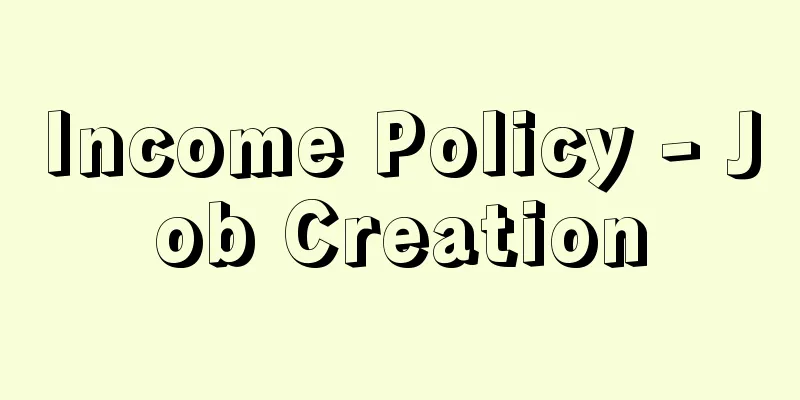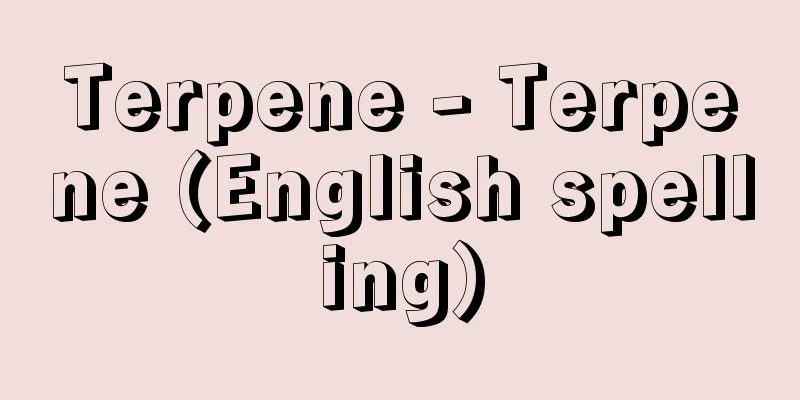Income Policy - Job Creation

|
This is a policy in which policy authorities maintain a balance between the growth of distributed national income and the growth of real national product by intervening in the process of formation of various incomes (wages, profits, interest, dividends, etc.) with the primary goal of price stability. [Mitomi Noriyoshi] Types of income policiesIncome policies are classified into three types according to the objectives and targets of the policy. The first type is narrow income policy, where the objective is price stability and the target is set solely on wages or prices. The second type is intermediate income policy, where the objective is price stability, as well as stabilizing the balance of payments, maintaining full employment, and avoiding economic stagnation, and the target is wages and other incomes (profits, interest, rent, self-employed income, capital gains, etc.). The third type is broad income policy, where in addition to the objectives and targets adopted in the intermediate policy, the former type includes the fairness of income distribution, and the latter type includes factors that indirectly regulate various incomes, such as weakening the bargaining power of labor unions and eliminating the monopoly power of companies, as well as active labor market policies. They can also be categorized into three types in terms of the means and actors of implementation. The first is called the direct regulation method, in which the government or government agencies are the policy actors and adopt compulsory or legislative measures. The second is called the inducement and persuasion method, in which the government or government agencies, or government policy agencies with representatives of labor, management, and capital, take the lead in adopting inducement and persuasion methods. This is the case when target values known as guide lines and guide posts are set. The third is called the discussion method, in which voluntary regulatory organizations centered on the parties involved, such as labor and management, take the lead in implementing self-regulation by labor and management. The actual development process of income policy is a combination of the three types based on purpose and target and the three types based on actor and means. [Mitomi Noriyoshi] UK Income PolicyHistorically, it began in 1962 when the UK's "Incomes White Paper: The Next Stage in Income Policy" set a standard of 2.0 to 2.5% as a guiding light for wage increases. After that, the UK presented a standard to limit wage increases to the national product growth rate. In 1963, the National Economic Development Council was established, and the Trade Union Congress (TUC), the largest central organization of labor unions, was allowed to join on a conditional basis, but resistance from workers spread, and wage increases that exceeded the standard continued. In 1964, the Ministry of Economy was established as the Ministry for Income Policy, and a joint declaration on productivity, prices and incomes was issued, signed by representatives of labor, management, and government. The following year, in 1965, the "Incomes White Paper" was published, which began by limiting price increases and set a 3.0 to 3.5% income increase rate commensurate with the predicted productivity growth rate. At the same time, the National Prices and Incomes Committee, which was responsible for monitoring the implementation of the policy and conducting research and recommendations, was established under a tripartite structure and began its activities. However, as wage increases continued to exceed the standard, the Price and Income Law was enacted to enforce the implementation of income policies. In 1966, the New Prices and Income Act was enacted, which included provisions to punish strikes that violated the government's order to postpone the implementation of wage increases. However, under pressure from workers, the TUC passed a resolution calling for the repeal of the Prices and Income Act with a high vote of 88% (1967). The income policy announced in 1972, which imposed strict restrictions on wages while imposing vague restrictions on prices and profits, provoked fierce resistance from workers, including indefinite strikes. In 1974, a large wage increase of nearly 30% was implemented, and the income policy had to collapse. For this reason, the government chose the path of a social contract, which extracted a promise from the labor unions to restrain wage increases in exchange for implementing measures such as the abolition of the Industrial Relations Act (1971) and legal restrictions on wage increases, price control, and the expansion of social security. However, this contract also failed to contain the rise in wages, and the government had to make it clear that the social contract had collapsed and that the income policy would be reintroduced through legal restrictions. [Mitomi Noriyoshi] Japan's income policyAlthough the income policy nominally regulates multiple incomes, in reality it is a national policy that restricts wages within the framework of labor productivity, and this was the basis for workers' resistance. In Japan, discussions on income policy became active from the late 1960s, and several reports (such as the Kumagai Report in 1968 and the Sumiya Report in 1972) were submitted. The basic position of the report, which sought to introduce the income policy into Japan, was accepted by the All-Japan Trade Union Confederation (Dōmei), and came to frame the setting of wage increases in subsequent spring labor offensives. In Japan, the Japan Federation of Employers' Associations (now the Japan Business Federation) provides guidelines, which is unique. Unlike the UK, the government does not legally regulate wage increases, but this has led to the stagnation of nominal wages and the decline of real wages since the late 1970s. [Mitomi Noriyoshi] "The Income Policy Debate" edited by G.P. Schultz and R.Z. Alibar, translated and supervised by Kanamori Hisao et al. (1968, Toyo Keizai Shinposha)" ▽ "Welfare Maximization and Price Stability" edited and published by Japan Productivity Center (1973)" ▽ "Wage Increases and the Crisis of Capitalism" by A. Glynn and B. Sutcliffe, translated by Hirai Noriyuki (1975, Diamond Publishing)" ▽ "Economic Analysis of Income Policy" by Okuno Hiroyuki (1982, Chuo Keizai Publishing) [References] | | |Source: Shogakukan Encyclopedia Nipponica About Encyclopedia Nipponica Information | Legend |
|
政策当局が物価の安定を主たる目的に、諸所得(賃金、利潤、利子、配当など)の形成過程に介入することによって、分配国民所得の成長と実質国民生産の成長との均衡を維持する政策である。 [三富紀敬] 所得政策の諸類型所得政策は、政策の目的と対象に関連して三つの型に分類される。第一は狭義の所得政策で、その目的が物価の安定に置かれ、対象がもっぱら賃金もしくは価格にのみ設定される場合である。第二は中間的な所得政策で、目的が物価の安定をはじめ国際収支の安定、完全雇用の維持、経済停滞の回避に置かれ、対象が賃金をはじめその他の諸所得(利潤、利子、地代、自営所得、資本利得など)に設定される場合である。第三は広義の所得政策で、中間的な政策の場合に採用される目的および対象のほかに、前者については所得分配の公正化、後者については諸所得を間接的に規制する要因、すなわち労働組合の交渉力の弱化および企業の独占力の排除や積極的労働市場政策の加えられる場合である。 また、実施の手段や主体にかかわっても三つに類型化される。第一は直接規制方式といわれるもので、この場合には政府・官庁が政策の主体になって強制的、立法的な措置が採用される。第二は誘導・説得方式とよばれるもので、この場合には政府・官庁もしくは労使(資)などの代表の参加する政府の政策機関が主体となって誘導と説得の手段が採用される。ガイド・ラインguide lineやガイド・ポストguide postといわれる目標値の示される場合が、これである。第三は話し合い方式といわれるもので、労使などの当事者中心の自主的な規制機関が主体となって労使による自主規制が行われる。所得政策の実際の展開過程は、目的と対象による三つの型と主体と手段による三つの型がそれぞれ組み合わされる。 [三富紀敬] イギリスの所得政策歴史的には1962年にイギリスの『所得白書――所得政策の次の段階』で、賃上げの指標(ガイディング・ライトguiding light)として2.0~2.5%の基準が示されたことに始まる。その後イギリスでは、賃金の引上げを国民生産増加率の枠内に抑える基準が提示された。1963年には国民経済開発審議会が設置され、最大の労働組合中央組織であるイギリス労働組合会議(TUC)の条件付き参加がなされたが、労働者の抵抗が広がり、基準を上回る賃上げが続出した。1964年には経済省が所得政策担当省として新設され、労使政三者代表の署名になる生産性、物価および所得に関する共同宣言が発表された。翌1965年には『物価所得白書』が発表され、物価引上げの抑制をはじめ、予測される生産性の上昇率に見合う所得の上昇率3.0~3.5%が設定された。同時に、政策の実施を監視し、調査・勧告する任を負う全国物価所得委員会が、三者構成のもとに設置され活動を始めた。しかし基準を超える賃上げが続出したため、物価所得法が制定され、所得政策の強制的な実施が図られた。 その後1966年には、政府の賃上げ実施延期命令に違反するストライキを処罰する項目を加えた新物価所得法も制定されたが、TUCは、職場労働者の抵抗に押され、88%の高率をもって物価所得法の撤廃要求決議を採択した(1967)。1972年に発表された所得政策は、あいまいな価格および利潤規制の一方で、賃金に対する厳しい規制を敷いたために、無期限ストライキを含む労働者の激しい抵抗を呼び起こした。1974年には30%近い大幅な賃上げが行われ、所得政策は崩壊せざるをえなかった。このため政府は、労使関係法(1971)と賃上げの法的規制の廃止をはじめ、物価の統制、社会保障の拡充などを行うことと引き換えに労働組合から賃上げ自制の約束を引き出すという社会契約の道を選んだ。しかし、この契約も賃金の上昇を抑えることができず、社会契約の破綻(はたん)と法的規制による所得政策の再導入が政府によって明らかにされなければならなかった。 [三富紀敬] 日本の所得政策所得政策は、名目的には複数の所得を規制するとしてはいるが、実質的には賃金を労働生産性の枠内に抑制する国家の政策であり、これが労働者の抵抗を呼び起こす基盤でもあった。日本では、1960年代後半から所得政策に関する議論が活発化し、いくつかの報告書(1968年の『熊谷(くまがい)報告』、1972年の『隅谷(すみや)報告』など)が提出された。所得政策を日本にも導入しようとする報告書の基本的な立場は、全日本労働総同盟(同盟)によっても受け入れられ、その後の春闘における賃上げ額の設定を枠づけることになった。日本の場合、日本経営者団体連盟(現日本経済団体連合会)がガイド・ラインを提示するところに特徴があり、イギリスのように政府が賃上げの法的規制を行うわけではないが、これによって1970年代後半以降における名目賃金額の停滞と実質賃金の低下という事態がつくりだされた。 [三富紀敬] 『G・P・シュルツ、R・Z・アリバー編、金森久雄他監訳『所得政策論争』(1968・東洋経済新報社)』▽『日本生産性本部編・刊『福祉極大化と物価安定』(1973)』▽『A・グリン、B・サトクリフ著、平井則之訳『賃上げと資本主義の危機』(1975・ダイヤモンド社)』▽『奥野博幸著『所得政策の経済分析』(1982・中央経済社)』 [参照項目] | | |出典 小学館 日本大百科全書(ニッポニカ)日本大百科全書(ニッポニカ)について 情報 | 凡例 |
Recommend
Haguro Mirror
This refers to mirrors discovered in Mitarai Pond,...
Kawauchiura
A district in the northeast of Hirado City, Nagas...
Katsue Kitazono
1902-1978 A poet from the Showa period. Born Octo...
Max Picard
[1888-1965] German physician and thinker. He deepl...
Return
…In local jargon from the Edo period, it refers t...
Recorder - recorder (English spelling)
A type of aerophone that does not use a reed. It ...
Uruguay potato wasp - Uruguay potato wasp
... Litomastix maculata , a parasitic wasp on the...
Secrets of official positions - Kanshoku Hisho
A book in two volumes detailing the standards and ...
Yuki [city] - Yuki
A city in western Ibaraki Prefecture. It was incor...
Amānullāh (English spelling) Amanullah
...However, one of the intellectuals who witnesse...
Stephanitis nashi (English spelling)
...Some species transmit plant pathogens such as ...
papyros
...Life without paper is completely unimaginable,...
Fukushima Domain
This domain ruled the area around Fukushima (Fuku...
Kamikawasaki
…Nihonyanagi and Aburai were post towns on the Os...
Brain-gut peptide
…Gastrin was discovered in 2005, and currently, i...









